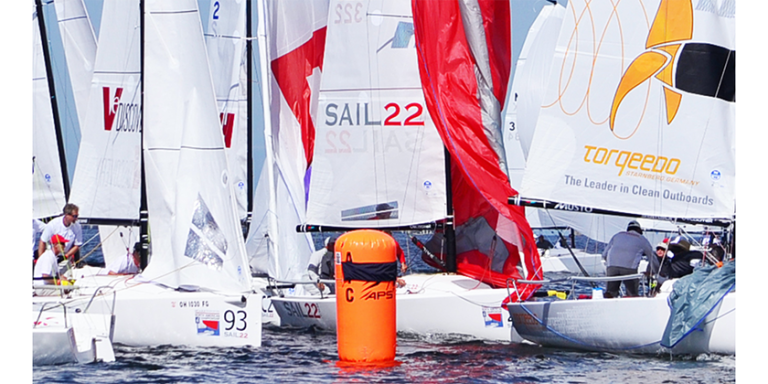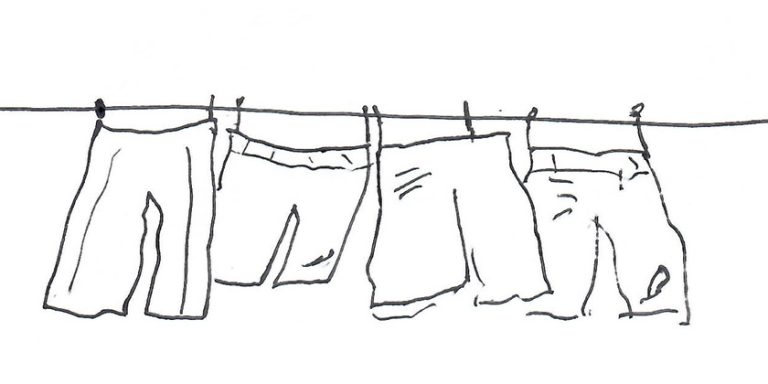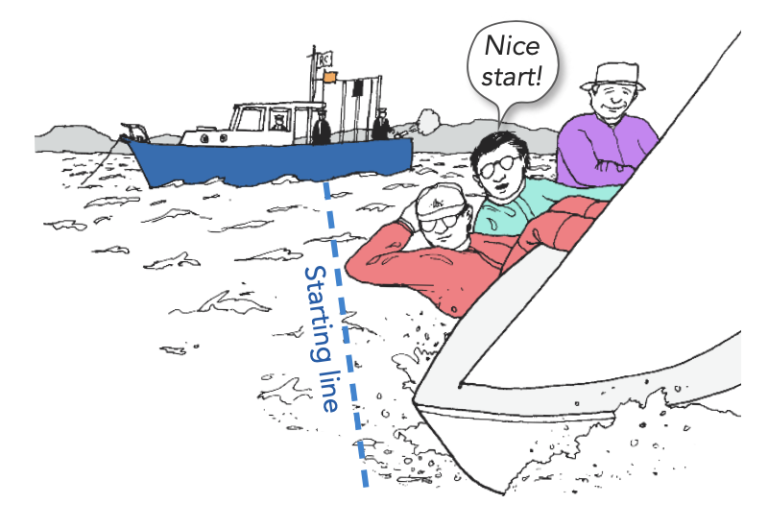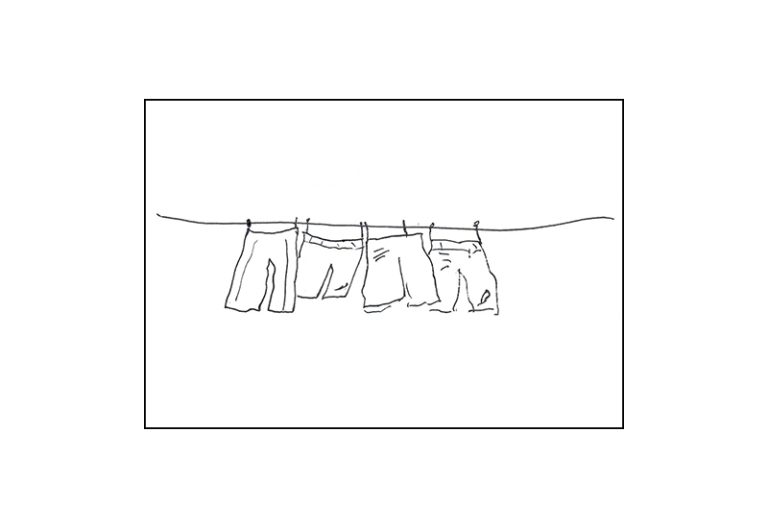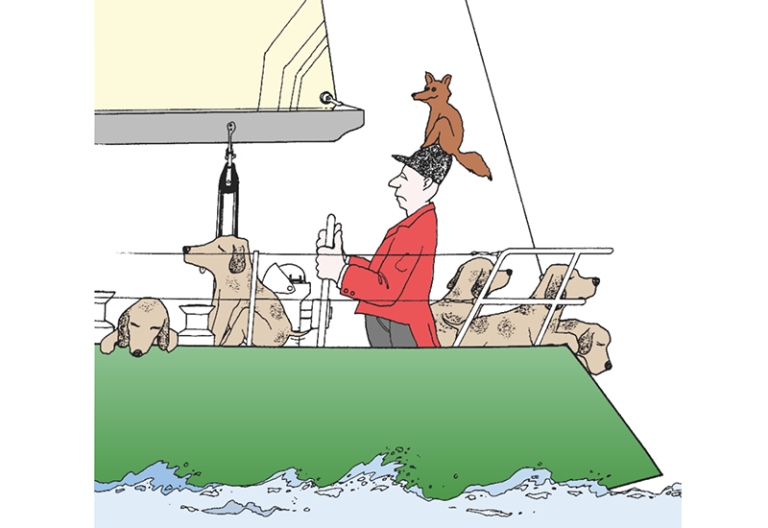Speed & Smarts: Ladder Rungs Part 2 – Wind Shifts
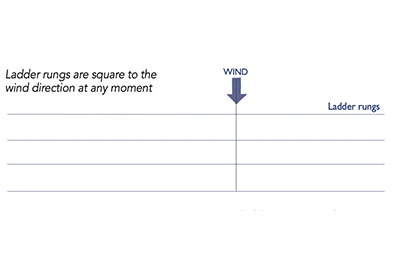
Mar 16, 2022
Figure 1
Ladder rungs are great tools for understanding how the wind direction affects boats racing up- wind or downwind. On most days the wind shifts constantly, even when it seems relatively steady, so ladder rungs (and the corresponding positions of boats in the fleet) are also changing continuously.
Whenever the wind changes direction, the boats that are closer to that shift move up the ladder, while boats farther away from it move down the ladder. Climbing up is good when you’re sailing upwind, but climbing down is the goal when sailing downwind. The basic rule of thumb, therefore, is to be closer to the next shift on a beat, but farther away from it on a run.
Ladder rungs are a function of the wind direction, but they’re not affected by wind velocity. Of course, wind pressure does affect how high or low boats can sail both upwind and downwind. This makes their angles look different, but it doesn’t affect ladder rungs.
When the wind changes direction: Since ladder rungs are always lined up perpendicular to the direction of the wind, their angle changes whenever the wind shifts. If the wind goes right (below Fig 2), the ladder rungs tilt a corresponding amount that way. Since the wind direction seldom stays constant for very long, ladder rungs are also constantly moving, and this can have a big impact on strategy and tactics.
Figure 2
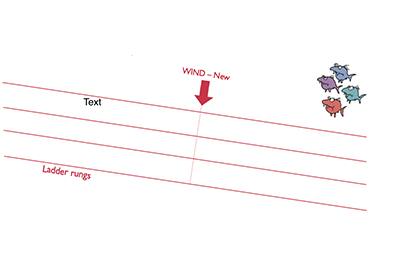
In the old breeze shown in blue on Figure 3, Green and Blue were on the same ladder rung, so they were even in the race. When the wind shifted to the right (red arrow), the ladder rungs also shifted accordingly.
Figure 3
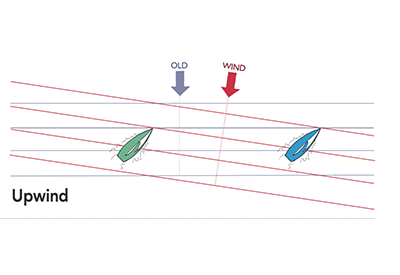
Whenever the wind changes direction clockwise to red arrow in Figure 3, the boat that is closer to the new wind (Blue in this case) always ends up on a higher ladder rung. Since being on a higher ladder rung is good when you’re racing upwind, this means Blue is now ahead of Green in the race in Figure 3.
On this downwind leg in Figure 4, Green and Blue were originally on the same ladder rung, so they were even in the race. When the wind shifted right (red arrow), the ladder rungs also shifted accordingly.
Whenever the wind changes direction, the boat that is closer to the new wind (Blue in this case) always ends up on a higher ladder rung. Since moving to a higher ladder rung is bad when you are racing downwind, this means Green is now ahead of Blue in the race.
Figure 4
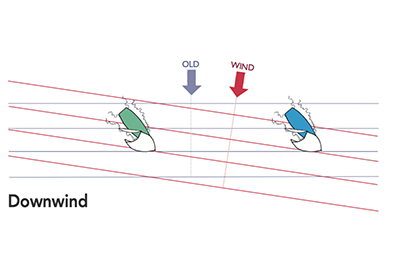
Leverage
We’ve been talking about a giant ladder superimposed on the race course which provides a great picture of where each boat stands relative to the rest of the fleet. The ladder rungs show which boats gain and lose when the wind shifts, but they don’t say anything about how much they gain or lose.
That depends on leverage, a measure of the lateral distance between boats. This concept of leverage is very important tactically and strategically because it deter- mines how much you will gain or lose to other boats when the wind shifts. The more leverage, the more that wind shifts affect positions.
Figure 5
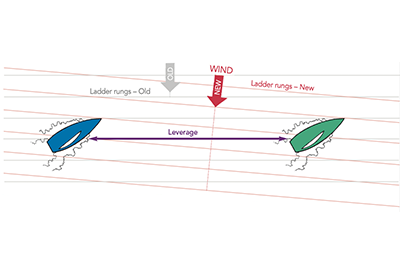
When two boats are racing upwind, the one on the higher ladder rung is ahead. If they are both on the same ladder rung, they are equal in the race, at least until the wind direction changes. When the wind shifts, one boat gains and the other loses (the boat closer to the shift gains upwind while the boat farther from the shift gains downwind). The amount of gain or loss depends on two things: 1) the size of the shift; and 2) the lateral distance (i.e., ‘leverage’) between the boats.
Use ‘fence posts’ to estimate leverage
When you want to know how much a boat will gain or lose in a wind shift, horizontal ladder rungs won’t help – you need to imagine vertical lines that are parallel to the wind direction. Think picket fence.
The more fence posts there are between boats, the more they are leveraged against each other, and the more they will gain or lose when the
wind direction changes.
Figure 6
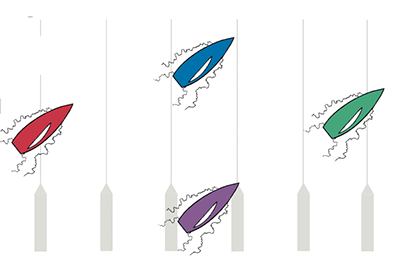
In this example in Figure 6, the Blue and Purple boats are on essentially the same fence post, so when the wind shifts neither boat will gain or lose much to the other. Red and Green, on the other hand, are separated by quite a few fence posts so they each have a lot of leverage. When the wind shifts, one will gain a lot and the other will lose a lot.
The mathematics of leverage and shifts
Here’s a chart that shows how two boats racing upwind will fare when the wind shifts in increments of five degrees. As you can see, the amount of gain and loss depends on the size of the shift and the lateral separation between boats (as well as the boats’ tacking angle).
Figure 7
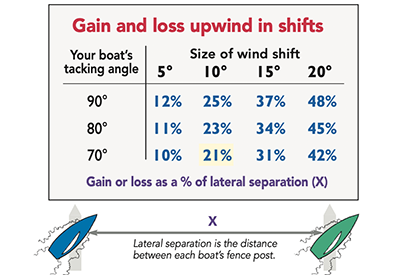
As an example, consider two boats (Blue and Green) that tack through 70° and are about 20 boatlengths apart on a beat. Then the wind shifts 10° to the right. The Green boat will gain, of course, because she is closer to the shift. The amount she gains will be about 21% of 20 boatlengths, or about 4 boatlengths!
We can make this much simpler so it’s easy to remember. As a rule of thumb, a wind shift of Z degrees produces a gain that is roughly 2 x Z % of the separation between boats. In other words, a 5° shift produces a gain of twice that, or 10%. A 10-degree shift means a gain of 20%. These gains can be quite big when boats have a lot of leverage.
 Dave Dellenbaugh is the publisher, editor and author of Speed & Smarts, the racing newsletter. He was the tactician and starting helmsman on America3 during her successful defense of the America’s Cup in 1992 and sailed in three other America’s Cup campaigns from 1986 to 2007. David is also two-time winner of the Canada’s Cup, a Lightning world champion, two-time Congressional Cup winner, seven-time Thistle national champion, three-time Prince of Wales U.S. match racing champion and past winner of the U.S. Team Racing Championship for the Hinman Trophy. He is currently a member of the US Sailing Racing Rules Committee (and was its chairman from 2005-2008).
Dave Dellenbaugh is the publisher, editor and author of Speed & Smarts, the racing newsletter. He was the tactician and starting helmsman on America3 during her successful defense of the America’s Cup in 1992 and sailed in three other America’s Cup campaigns from 1986 to 2007. David is also two-time winner of the Canada’s Cup, a Lightning world champion, two-time Congressional Cup winner, seven-time Thistle national champion, three-time Prince of Wales U.S. match racing champion and past winner of the U.S. Team Racing Championship for the Hinman Trophy. He is currently a member of the US Sailing Racing Rules Committee (and was its chairman from 2005-2008).
You can subscribe to the Speed & Smarts newsletter HERE

